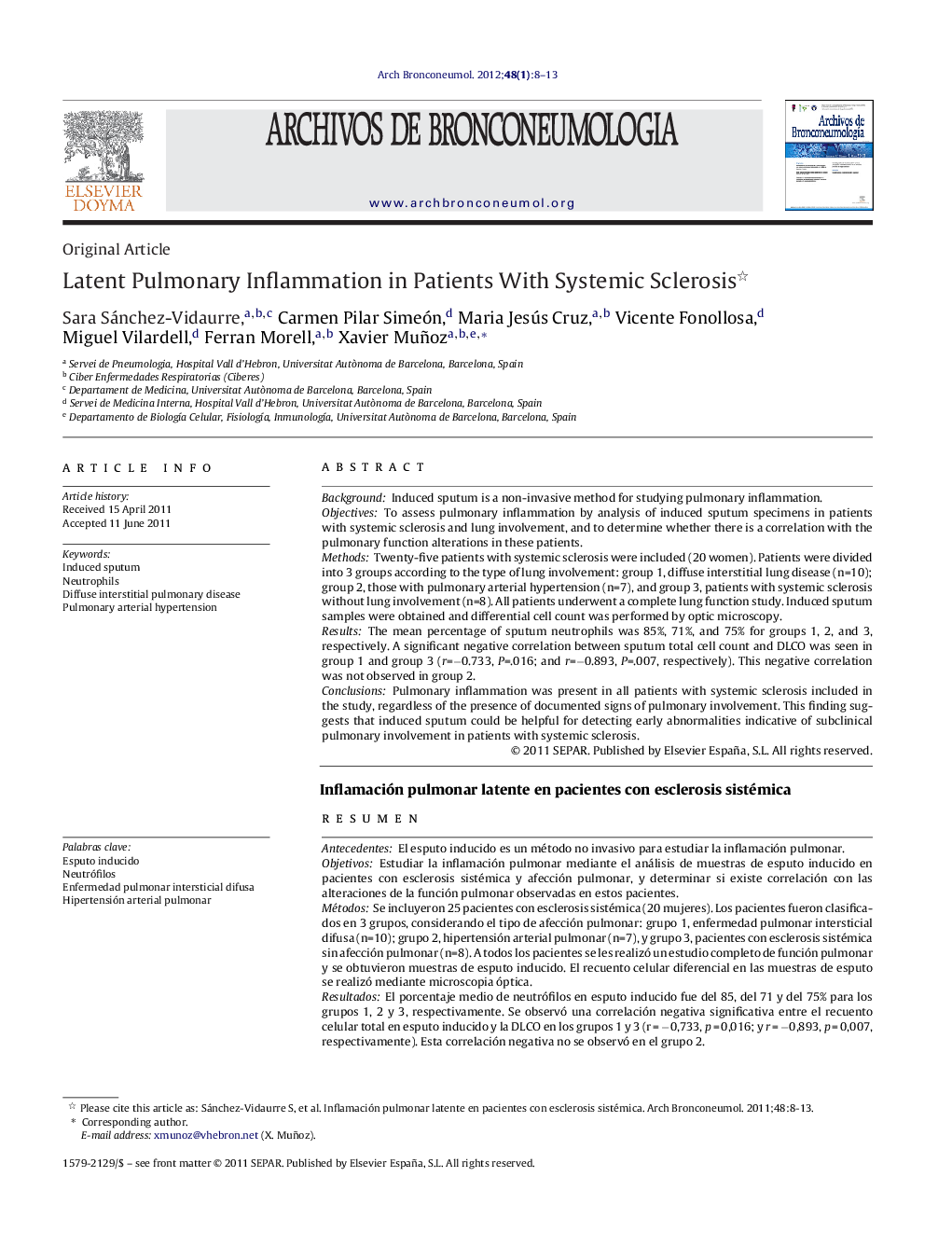| کد مقاله | کد نشریه | سال انتشار | مقاله انگلیسی | نسخه تمام متن |
|---|---|---|---|---|
| 4206063 | 1279956 | 2012 | 6 صفحه PDF | دانلود رایگان |

BackgroundInduced sputum is a non-invasive method for studying pulmonary inflammation.ObjectivesTo assess pulmonary inflammation by analysis of induced sputum specimens in patients with systemic sclerosis and lung involvement, and to determine whether there is a correlation with the pulmonary function alterations in these patients.MethodsTwenty-five patients with systemic sclerosis were included (20 women). Patients were divided into 3 groups according to the type of lung involvement: group 1, diffuse interstitial lung disease (n=10); group 2, those with pulmonary arterial hypertension (n=7), and group 3, patients with systemic sclerosis without lung involvement (n=8). All patients underwent a complete lung function study. Induced sputum samples were obtained and differential cell count was performed by optic microscopy.ResultsThe mean percentage of sputum neutrophils was 85%, 71%, and 75% for groups 1, 2, and 3, respectively. A significant negative correlation between sputum total cell count and DLCO was seen in group 1 and group 3 (r=−0.733, P=.016; and r=−0.893, P=.007, respectively). This negative correlation was not observed in group 2.ConclusionsPulmonary inflammation was present in all patients with systemic sclerosis included in the study, regardless of the presence of documented signs of pulmonary involvement. This finding suggests that induced sputum could be helpful for detecting early abnormalities indicative of subclinical pulmonary involvement in patients with systemic sclerosis.
ResumenAntecedentesEl esputo inducido es un método no invasivo para estudiar la inflamación pulmonar.ObjetivosEstudiar la inflamación pulmonar mediante el análisis de muestras de esputo inducido en pacientes con esclerosis sistémica y afección pulmonar, y determinar si existe correlación con las alteraciones de la función pulmonar observadas en estos pacientes.MétodosSe incluyeron 25 pacientes con esclerosis sistémica (20 mujeres). Los pacientes fueron clasificados en 3 grupos, considerando el tipo de afección pulmonar: grupo 1, enfermedad pulmonar intersticial difusa (n=10); grupo 2, hipertensión arterial pulmonar (n=7), y grupo 3, pacientes con esclerosis sistémica sin afección pulmonar (n=8). A todos los pacientes se les realizó un estudio completo de función pulmonar y se obtuvieron muestras de esputo inducido. El recuento celular diferencial en las muestras de esputo se realizó mediante microscopia óptica.ResultadosEl porcentaje medio de neutrófilos en esputo inducido fue del 85, del 71 y del 75% para los grupos 1, 2 y 3, respectivamente. Se observó una correlación negativa significativa entre el recuento celular total en esputo inducido y la DLCO en los grupos 1 y 3 (r = −0,733, p = 0,016; y r = −0,893, p = 0,007, respectivamente). Esta correlación negativa no se observó en el grupo 2.ConclusionesEn todos los pacientes con esclerosis sistémica incluidos en el estudio se detectó inflamación pulmonar, a pesar de la presencia o no de signos documentados de afección pulmonar. Este hallazgo sugiere que el esputo inducido podría ser una técnica útil para detectar anomalías tempranas indicativas de afección pulmonar subclínica en pacientes con esclerosis sistémica.
Journal: Archivos de Bronconeumología (English Edition) - Volume 48, Issue 1, January 2012, Pages 8–13